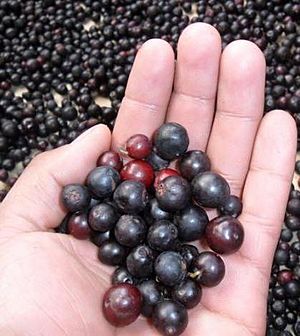Vaccinium meridionale facts for kids
Quick facts for kids Vaccinium meridionale |
|
|---|---|
 |
|
| Scientific classification | |
| Genus: |
Vaccinium
|
| Species: |
meridionale
|
| Synonyms | |
|
|
The Agraz (scientific name: Vaccinium meridionale), also known as the Andean blueberry, is a type of plant found in the mountains of South America. It belongs to the same family as blueberries and heathers. You can find it growing in countries like Ecuador, Colombia, and Venezuela. It might also be in Jamaica.
People often pick its fruit from the wild. It's a popular berry sold in local markets and stores because it's healthy. Even when people grow it, they often let it grow almost like it would in the wild.
Contents
What Does Agraz Look Like?
The Agraz plant is a shrub that can grow quite tall. It usually reaches between 1.5 meters (about 5 feet) and 7 meters (about 23 feet) in height.
Leaves and Flowers
Its leaves are simple and grow one after another along the stem. They are shaped like an oval and feel a bit leathery. The tip of the leaf is sharp, and its edges have small, rounded teeth.
The flowers of the Agraz plant are usually white. Sometimes, they might have hints of pink or red. These flowers grow in clusters, with about 10 to 15 flowers in each group.
Agraz Fruit
The fruit of the Agraz plant is round. It's about 1.2 centimeters (half an inch) wide. When the fruit is young, it's green. As it ripens, it turns a dark red color, which can look almost black or purple.
The ripe Agraz fruit has a tart, slightly sour taste. This makes it great for many different foods and drinks.
How Agraz Plants Grow
Agraz plants are often grown in special plots. Farmers usually plant them about 3 meters apart in rows that are 2 meters apart. They try not to change the natural environment too much, as Agraz grows well in wild conditions.
Starting New Plants
The best way to grow new Agraz plants is by using small plants that have roots growing from older vines. This method helps the new plants grow strong.
If you use seeds, the young plants need about a year and a half before they are big enough to be moved to their permanent spot. If you use cuttings (pieces of branches), they can be transplanted in about six months once they have rooted.
Plant Lifespan
Agraz plants can live for a very long time, sometimes up to 80 years! They also produce fruit twice a year, which is great for farmers.
Plant Genetics
Agraz plants are special because they can make copies of themselves. This means they can produce new plants that are exactly like the parent plant. This is called "vegetative reproduction."
However, Agraz plants also reproduce in the usual way, with seeds. This mix of reproduction methods helps keep the plants genetically diverse. To make sure there's a good variety of Agraz plants, it's important to collect seeds from different plants.
Agraz in Colombia
In Colombia, Agraz plants are found in the mountains at high altitudes. They grow between 2,200 meters (about 7,200 feet) and 3,400 meters (about 11,150 feet) above sea level. Colombia is the only tropical country that gets two harvests of this fruit each year.
Researchers from a university in Medellin, Colombia, have studied Agraz crops. They looked at plants in different areas, including Guachetá, California, La Ceja, Santa Rosa de Osos, and Entrerríos.
Their studies found that these red berries change as they ripen. These changes affect how many antioxidants they have. Antioxidants are good for your body and help keep you healthy. Agraz berries are often eaten after they have been processed, for example, in juices or jams.
See also
 In Spanish: Agraz silvestre para niños
In Spanish: Agraz silvestre para niños

